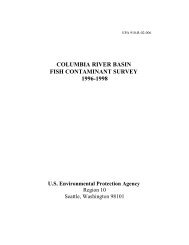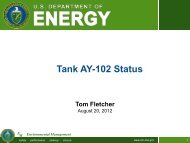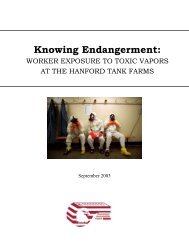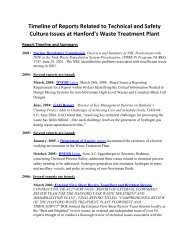Reducing the Risks of High-Level Radioactive Wastes at Hanford
Reducing the Risks of High-Level Radioactive Wastes at Hanford
Reducing the Risks of High-Level Radioactive Wastes at Hanford
You also want an ePaper? Increase the reach of your titles
YUMPU automatically turns print PDFs into web optimized ePapers that Google loves.
78 Alvarez<br />
nitr<strong>at</strong>es and cesium; it may also contain up to 2 percent suspended solids or solids<br />
o<strong>the</strong>rwise entrained by <strong>the</strong> waste transfers. Three envelopes <strong>of</strong> LAW have been defined:<br />
Envelope A is standard, Envelope B contains higher levels <strong>of</strong> cesium, and Envelope C<br />
contains higher levels <strong>of</strong> strontium and TRU ....LAW would come from <strong>the</strong> liquid phases<br />
<strong>of</strong> <strong>the</strong> DSTs and from solids washing oper<strong>at</strong>ions. From a regul<strong>at</strong>ory perspective, LAW is<br />
still HLW and has high radi<strong>at</strong>ion levels requiring handling within shielded structures.<br />
DOE identifies <strong>the</strong> solid phases as HLW, defined as Envelope D .... Envelope D contains<br />
cesium, strontium, and TRUs as <strong>the</strong> radionuclides. Metal oxides, hydroxides, nitr<strong>at</strong>es,<br />
phosph<strong>at</strong>es, and alumin<strong>at</strong>es constitute <strong>the</strong> bulk <strong>of</strong> <strong>the</strong> chemical species.”<br />
52. U.S. Department <strong>of</strong> Energy, Technical Basis for Classific<strong>at</strong>ion <strong>of</strong> Low-Activity<br />
Waste Fraction from <strong>Hanford</strong> Site Tanks Westinghouse <strong>Hanford</strong> Corpor<strong>at</strong>ion, WHC-<br />
SD-WM-TI-699, September 1996. (Hereafter known as WHC-SD-WM-TI-699.)<br />
53. U.S. Nuclear Regul<strong>at</strong>ory Commission, Letter to: Mr. Jackson Kinzer, Office <strong>of</strong> Tank<br />
Remedi<strong>at</strong>ion System, U.S. Department <strong>of</strong> Energy, Richland Oper<strong>at</strong>ions Office, From:<br />
Carl J. Paperiello, Director, Office <strong>of</strong> Nuclear M<strong>at</strong>erial Safety and Safeguards, June 9,<br />
1997.<br />
54. U.S. Department <strong>of</strong> Energy, Final Environmental Impact St<strong>at</strong>ement for a Geologic<br />
Repository for <strong>the</strong> Disposal <strong>of</strong> Spent Nuclear Fuel and <strong>High</strong>-<strong>Level</strong> <strong>Radioactive</strong> Waste<br />
<strong>at</strong> Yucca Mountain, Nye County, Nevada DOE/EIS-0250, February 2002, Appendix A,<br />
Table A-28. (Hereafter known as DO/EIS-0250.) DOE estim<strong>at</strong>es th<strong>at</strong> <strong>the</strong> total amount<br />
<strong>of</strong> chemicals in HLW glass forms <strong>at</strong> <strong>Hanford</strong> is 44,000 Kgs., compared to <strong>the</strong> total 15.1<br />
million kilograms currently estim<strong>at</strong>ed in storage tanks.<br />
55. DOE/EIS-0250, February 2002, Appendix A, p. A-39.<br />
56. St<strong>at</strong>ement <strong>of</strong> Jurisdiction, U.S. Ninth Circuit Court <strong>of</strong> Appeals, Re: NRDC v. Abraham,<br />
244 F.3d 742 (9th Cir. 2003), January 29, 2004, p. 40.<br />
57. DOE/EIS-0250, February 2002, Appendix A, Tables A-8, A-20 and A-27, <strong>at</strong> pages<br />
A-16, and A-40, respectively. Based on <strong>the</strong>se tables, DOE has determined th<strong>at</strong> approxim<strong>at</strong>ely<br />
63,000 metric tons <strong>of</strong> <strong>the</strong> total capacity <strong>of</strong> Yucca Mountain should be reserved<br />
for commercial spent nuclear fuel. The remaining 7,000 metric tons (or 10 percent) <strong>of</strong><br />
<strong>the</strong> repository’s capacity would be available for <strong>the</strong> disposal <strong>of</strong> 2,333 metric tons <strong>of</strong> DOE<br />
spent nuclear fuel and approxim<strong>at</strong>ely 8,315 canisters (4,667 metric tons) containing solidified<br />
high-level radioactive waste from all defense sources. DOE estim<strong>at</strong>es, however,<br />
th<strong>at</strong> if all commercial nuclear facilities licenses are extended for 10 years, by 2046 <strong>the</strong>re<br />
will be in existence approxim<strong>at</strong>ely 105,000 metric tons <strong>of</strong> commercial spent nuclear fuel,<br />
and th<strong>at</strong> by 2035 <strong>the</strong>re will be approxim<strong>at</strong>ely 2,500 metric tons <strong>of</strong> DOE spent nuclear<br />
fuel and 22,280 canisters <strong>of</strong> DOE HLW.<br />
58. DOE/EIS-0250 February 2002, Appendix A., p. 40.<br />
59. U.S. Department <strong>of</strong> Energy, an Evalu<strong>at</strong>ion <strong>of</strong> Commercial Repository Capacity for<br />
<strong>the</strong> Disposal <strong>of</strong> Defense <strong>High</strong>-<strong>Level</strong> Waste, DOE/DP0021/1 June 1985.<br />
60. U.S. Nuclear Regul<strong>at</strong>ory Commission. Memorandum for Joseph Browning, Director,<br />
Division <strong>of</strong> Waste Management, From: Neil J. Numarck, Policy and Program Control<br />
Branch, Subject: Clarific<strong>at</strong>ion <strong>of</strong> DOE-Richland Comments on Defense Waste Commingling<br />
Study, March 14, 1985.<br />
61. Ibid.<br />
62. Ibid.<br />
63. Arjun Makhijani, and Michelle Boyd, Nuclear Dumps by <strong>the</strong> Riverside: Thre<strong>at</strong>s<br />
to <strong>the</strong> Savannah River from Contamin<strong>at</strong>ion <strong>at</strong> <strong>the</strong> Savannah River Site, Institute<br />
for Energy and Environmental Research, March 11, 2001, Takoma Park MD,<br />
p. 22.







